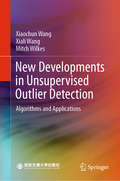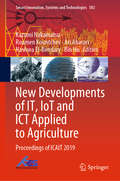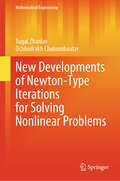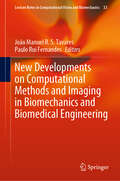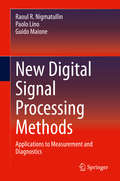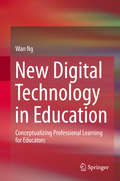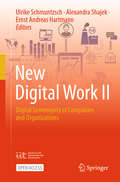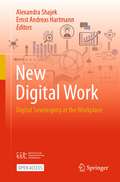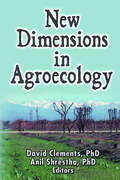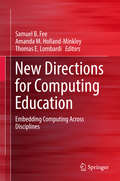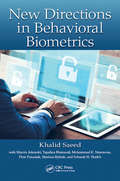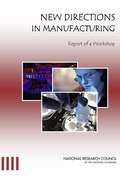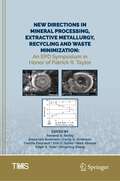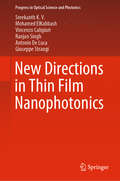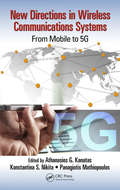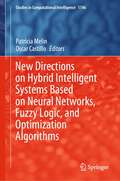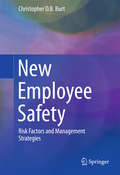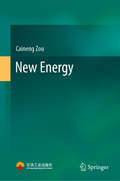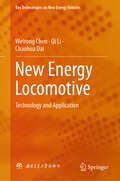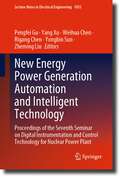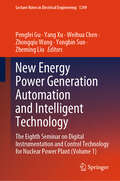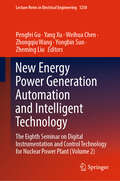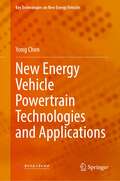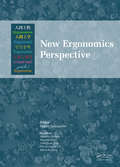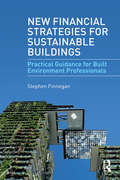- Table View
- List View
New Developments in Unsupervised Outlier Detection: Algorithms and Applications
by Xiaochun Wang Xiali Wang Mitch WilkesThis book enriches unsupervised outlier detection research by proposing several new distance-based and density-based outlier scores in a k-nearest neighbors’ setting. The respective chapters highlight the latest developments in k-nearest neighbor-based outlier detection research and cover such topics as our present understanding of unsupervised outlier detection in general; distance-based and density-based outlier detection in particular; and the applications of the latest findings to boundary point detection and novel object detection. The book also offers a new perspective on bridging the gap between k-nearest neighbor-based outlier detection and clustering-based outlier detection, laying the groundwork for future advances in unsupervised outlier detection research.The authors hope the algorithms and applications proposed here will serve as valuable resources for outlier detection researchers for years to come.
New Developments of IT, IoT and ICT Applied to Agriculture: Proceedings of ICAIT 2019 (Smart Innovation, Systems and Technologies #183)
by Bin Hu Kazumi Nakamatsu Roumen Kountchev Nashwa El-Bendary Ari AharariThe proceedings publishes new research results of scholars from the First International Conference on Agriculture and Information (ICAIT2019) organized by IRNet International Academic Communication Center, held during November 22-24, 2019. The book covers works from active researchers who are working on collaboration of agriculture and various information technologies such as ICT (Information and Communication Technologies) applicable/applied to agricultural produce, manufacturing preservation and distribution of agricultural products, etc. The book focuses on theory, design, development, testing and evaluation of all information technologies applicable/applied to various parts of agriculture and its infrastructure. The topics included are information technologies applicable to smart agriculture, intelligent information systems for smart farm systems, web-based intelligent information systems on agriculture, ICT-based marketing of agricultural products, agricultural product consumption network systems, IoT for agricultural produce and products, soft computing theories, intelligent management for agriculture, data science techniques for agriculture.
New Developments of Newton-Type Iterations for Solving Nonlinear Problems (Mathematical Engineering)
by Tugal Zhanlav Ochbadrakh ChuluunbaatarThis comprehensive book delves into the intricacies of Newton-type methods for nonlinear equations, offering insights into their convergence, accelerations, and extensions. Divided into three parts, the book explores higher-order iterations for nonlinear equations and their systems, and their applications in linear algebra and some nonlinear problems of theoretical physics. Emphasizing the pivotal role of iteration parameters in shaping convergence and expanding the domain, the authors draw from their extensive collaborative research to systematically compile and elucidate these findings. Catering to readers, graduate students, and researchers in applied mathematics, numerical analysis, and related disciplines, this book serves as a valuable resource, synthesizing decades of research to advance understanding and practical application in the field
New Developments on Computational Methods and Imaging in Biomechanics and Biomedical Engineering (Lecture Notes in Computational Vision and Biomechanics #999)
by Paulo Rui Fernandes João Manuel R. S. TavaresThis book gathers selected, extended and revised contributions to the 15th International Symposium on Computer Methods in Biomechanics and Biomedical Engineering (CMBBE2018), and the 3rd Conference on Imaging and Visualization, which took place on 26-29 March, 2018, in Lisbon, Portugal. The respective chapters highlight cutting-edge methods, e.g. new algorithms, image analysis techniques, and multibody modeling methods; and new findings obtained by applying them in biological and/or medical contexts. Original numerical studies, Monte Carlo simulations, FEM analyses and reaction-diffusion models are described in detail, together with intriguing new applications. The book offers a timely source of information for biologists, engineers, applied mathematicians and clinical researchers working on multidisciplinary projects, and is also intended to foster closer collaboration between these groups.
New Digital Signal Processing Methods: Applications to Measurement and Diagnostics
by Raoul R. Nigmatullin Paolo Lino Guido MaioneThis book is intended as a manual on modern advanced statistical methods for signal processing. The objectives of signal processing are the analysis, synthesis, and modification of signals measured from different natural phenomena, including engineering applications as well. Often the measured signals are affected by noise, distortion and incompleteness, and this makes it difficult to extract significant signal information. The main topic of the book is the extraction of significant information from measured data, with the aim of reducing the data size while keeping the basic information/knowledge about the peculiarities and properties of the analyzed system; to this aim, advanced and recently developed methods in signal analysis and treatment are introduced and described in depth. More in details, the book covers the following new advanced topics (and the corresponding algorithms), including detailed descriptions and discussions: the Eigen-Coordinates (ECs) method, The statistics of the fractional moments, The quantitative "universal" label (QUL) and the universal distribution function for the relative fluctuations (UDFRF), the generalized Prony spectrum, the Non-orthogonal Amplitude Frequency Analysis of the Smoothed Signals (NAFASS), the discrete geometrical invariants (DGI) serving as the common platform for quantitative comparison of different random functions. Although advanced topics are discussed in signal analysis, each subject is introduced gradually, with the use of only the necessary mathematics, and avoiding unnecessary abstractions. Each chapter presents testing and verification examples on real data for each proposed method. In comparison with other books, here it is adopted a more practical approach with numerous real case studies.
New Digital Technology in Education
by Wan NgThis book addresses the issues confronting educators in the integration of digital technologies into their teaching and their students' learning. Such issues include a skepticism of the added value of technology to educational learning outcomes, the perception of the requirement to keep up with the fast pace of technological innovation, a lack of knowledge of affordable educational digital tools and a lack of understanding of pedagogical strategies to embrace digital technologies in their teaching. This book presents theoretical perspectives of learning and teaching today's digital students with technology and propose a pragmatic and sustainable framework for teachers' professional learning to embed digital technologies into their repertoire of teaching strategies in a systematic, coherent and comfortable manner so that technology integration becomes an almost effortless pedagogy in their day-to-day teaching. The materials in this book are comprised of original and innovative contributions, including empirical data, to existing scholarship in this field. Examples of pedagogical possibilities that are both new and currently practised across a range of teaching contexts are featured.
New Digital Work II: Digital Sovereignty of Companies and Organizations
by Ernst Andreas Hartmann Alexandra Shajek Ulrike SchmuntzschThis book is an open access book. Following the edited volume ‘New Digital Work’ focusing on Digital Sovereignty at the workplace, this volume with the title ‘New Digital Work II’ provides insights into aspects of Digital Sovereignty of companies and organizations and its implications for those. It aims to broaden the views of the previous book beyond the significance of digital work for workers and their respective workplaces to companies and entire industry branches. To this end, not only common challenges concerning the Digital Sovereignty of companies and organizations but also suggestions, best practice examples, and thoughts from different academic perspectives and industry sectors are included. Various interdisciplinary contributions from computer science, economics, social sciences, HR management, organizational psychology and human factors, mechanical and industrial engineering, and law address different building blocks of Digital Sovereignty of companies and organizations.
New Digital Work: Digital Sovereignty at the Workplace
by Ernst Andreas Hartmann Alexandra ShajekThis open access book will give insights into global issues of work and work systems design from a wide range of perspectives. Topics like the impact of AI in the workplace as well as design for digital sovereignty at the workplace or foresight processes for digital work are covered. Practical cases, empirical results and theoretical considerations are not only taken from Germany and Europe, but also from Southeast Asia, South Africa, Middle America, and Australia. The book intends to expand the so far national view on the aspects of digital work (e.g. like in Ernst Hartmann’s immensely successful work “Zukunft der Arbeit in Industrie 4.0”) into an international context – thus showing not only common challenges, but also offering suggestions, best practice examples or thoughts from different global regions.
New Dimensions in Agroecology
by Anil Shrestha David ClementsReduce the environmentally negative aspects of industrial agriculture with an ecologically sound philosophy! New Dimensions in Agroecology explores the latest developments in the emerging science of agroecology, focusing on how these new concepts and cutting-edge tools will help minimize the impact of agriculture on the environment and fos
New Directions for Computing Education
by Samuel B. Fee Amanda M. Holland-Minkley Thomas E. LombardiWhy should every student take a computing course? What should be the content of these courses? How should they be taught, and by whom? This book addresses these questions by identifying the broader reaches of computing education, problem-solving and critical thinking as a general approach to learning.The book discusses new approaches to computing education, and considers whether the modern ubiquity of computing requires an educational approach that is inherently interdisciplinary and distinct from the traditional computer science perspective. The alternative approach that the authors advocate derives its mission from an intent to embed itself within an interdisciplinary arts and science context.An interdisciplinary approach to computing is compellingly valuable for students and educational institutions alike. Its goal is to support the educational and intellectual needs of students with interests in the entire range of academic disciplines. It capitalizes on students’ focus on career development and employers’ demand for technical, while also engaging a diverse student body that may not possess a pre-existing interest in computing for computing’s sake. This approach makes directly evident the applicability of computer science topics to real-world interdisciplinary problems beyond computing and recognizes that technical and computational abilities are essential within every discipline. The book offers a valuable resource for computer science and computing education instructors who are presently re-thinking their curricula and pedagogical approaches and are actively trying new methods in the classroom. It will also benefit graduate students considering a future of teaching in the field, as well as administrators (in both higher education and high schools) interested in becoming conversant in the discourse surrounding the future of computing education.
New Directions in Behavioral Biometrics
by Khalid SaeedAutomatic biometrics recognition techniques are increasingly important in corporate and public security systems and have increased in methods due to rapid field development. This book discusses classic behavioral biometrics as well as collects the latest advances in techniques, theoretical approaches, and dynamic applications. This future-looking book is an important reference tool for researchers, practitioners, academicians, and technologists. While there are existing books that focus on physiological biometrics or algorithmic approaches deployed in biometrics, this book addresses a gap in the existing literature for a text that is solely dedicated to the topic of behavioral biometrics.
New Directions in Manufacturing: Report of a Workshop
by Committee on New Directions in ManufacturingThe processes and techniques of manufacturing have changed substantially over the decades and that evolution continues today. In order to examine the potential impacts of these changes, the Department of Commerce asked the NRC to design a workshop to focus on issues central to the changing nature of manufacturing. The workshop brought together a number of experts to present papers about and to discuss the current state of manufacturing in the United States and the challenges it faces. This report presents the results of that workshop. Key challenges that emerged from the workshop and that are discussed include understanding manufacturing trends; manufacturing globalization; information technology opportunities; maintaining innovation; strengthening small and medium-sized enterprises; workforce education; and rising infrastructure costs.
New Directions in Mineral Processing, Extractive Metallurgy, Recycling and Waste Minimization: An EPD Symposium in Honor of Patrick R. Taylor (The Minerals, Metals & Materials Series)
by Mark Strauss Mingming Zhang Camille Fleuriault Alexandra Anderson Ramana G. Reddy Corby G. Anderson Erik D. Spiller Edgar E. VidalThis collection addresses new research and technology for increased efficiency, energy reduction, and waste minimization in mineral processing, extractive metallurgy, and recycling. Professor Patrick R. Taylor and his students have been studying these topics for the past 45 years. Chapters include new directions in:· Mineral Processing · Hydrometallurgy · Pyrometallurgy · Electrometallurgy · Metals and E waste recycling · Waste minimization (including by-product recovery) · Innovations in metallurgical engineering education and curriculum development
New Directions in Thin Film Nanophotonics (Progress in Optical Science and Photonics #6)
by Mohamed ElKabbash Vincenzo Caligiuri Ranjan Singh Giuseppe Strangi Sreekanth K. V. Antonio De LucaThis book highlights recent advances in thin-film photonics, particularly as building blocks of metamaterials and metasurfaces. Recent advances in nanophotonics has demonstrated remarkable control over the electromagnetic field by tailoring the optical properties of materials at the subwavelength scale which results in the emergence of metamaterials and metasurfaces. However, most of the proposed platforms require intense lithography which makes them of minor practical relevance. Stacked ultrathin-films of dielectrics, semi-conductors, and metals are introduced as an alternative platform that perform unique or similar functionalities. This book discusses the new era of thin film photonics and its potential applications in perfect and selective light absorption, structural coloring, biosensing, enhanced spontaneous emission, reconfigurable photonic devices and super lensing.
New Directions in Wireless Communications Systems: From Mobile to 5G
by Athanasios G. Kanatas, Konstantina S. Nikita and Panagiotis MathiopoulosBeyond 2020, wireless communication systems will have to support more than 1,000 times the traffic volume of today's systems. This extremely high traffic load is a major issue faced by 5G designers and researchers. This challenge will be met by a combination of parallel techniques that will use more spectrum more flexibly, realize higher spectral efficiency, and densify cells. Novel techniques and paradigms must be developed to meet these goals. The book addresses diverse key-point issues of next-generation wireless communications systems and identifies promising solutions. The book's core is concentrated to techniques and methods belonging to what is generally called radio access network.
New Directions on Hybrid Intelligent Systems Based on Neural Networks, Fuzzy Logic, and Optimization Algorithms (Studies in Computational Intelligence #1146)
by Oscar Castillo Patricia MelinThis book contains a collection of papers focused on hybrid intelligent systems based on soft computing techniques. In this book, new directions on the theoretical developments of fuzzy logic, neural networks and optimization algorithms, as well as their hybrid combinations, are offered. In addition, the abovementioned methods are discussed in application areas such as control and robotics, pattern recognition, medical diagnosis, decision-making, prediction and optimization of complex problems. There are a group of papers with the main theme of type-1, type-2 and type-3 fuzzy logic, which basically consists of papers that propose new concepts and algorithms based on type-1, type-2 and type-3 fuzzy logic and their applications. There is also a set of papers that offer theoretical concepts and applications of meta-heuristics in different areas. Another group of papers outlines diverse applications of hybrid intelligent systems in real problems. There are also some papers that presenttheory and practice of neural networks in different applications. Finally, there are papers that offer theory and practice of optimization and evolutionary algorithms in different application areas
New Employee Safety
by Christopher D. B. BurtThis reference introduces an innovative new-employee safety risk model, keyed to a typical new worker becoming acclimated to a new job and workplace. It reviews risk factors, their root causes, and how they can be addressed and minimized through targeted strategies at each stage of a worker's early months on the job. The model and its supporting findings dovetail with current thinking on employee safety and organizational accountability. And, of extra benefit to employers, the risk management strategies to improve new employee safety can be undertaken with minimal expenditure of time, money, and disruption. The book's real-world framework: · Analyzes high accident rates among new hires. · Describes four basic types of job applicants and safety concerns common to each. · Examines the role of recruitment and selection processes in promoting employee safety. · Discusses safety benefits and risks surrounding pre-start training. · Models the use of new employees' job familiarization to minimize safety risks. · Identifies safety risks associated with helping behaviors. · Identifies employee measures that can be used in assessing job safety risk. · Integrates safety management strategies with other human resource management activities New Employee Safety provides clear practical guidance to individuals involved in occupational safety management. The book makes a useful text for undergraduate and postgraduate courses on occupational safety management, and in fields such as behavioral science, psychology, business management, and human resources.
New Energy
by Caineng ZouThis book comprehensively and systematically introduces the principles, key technologies and main types of new energy utilization based on the analysis and prospect of global energy development trend and energy transformation law. Starting from the basic law of energy development, this book points out the inevitability of the development of fossil energy to non-fossil new energy, expounds scientifically and prospectively the importance of developing new energy to conform to the law of energy development and to ensure national energy security, introduces in detail various new energy technologies, summarizes the new strategies of traditional energy companies, and expounds respectively current situation and application prospect. The book is divided into four parts. The first one is "Energy Trend" includes the law of energy development, world energy layout and energy development trend. The second part, "New Energy Revolution", includes revolutionary energy technology and energy Internet technology. The third part is "New Strategies of Traditional Energy Companies", which includes the new energy distribution of oil companies and coal-fired power companies. Part IV "New Energy Theories", includes hydrogen energy, energy storage and new materials, geothermal, nuclear energy, wind and tide and other new energy sources.
New Energy Locomotive: Technology and Application (Key Technologies on New Energy Vehicles)
by Qi Li Weirong Chen Chaohua DaiThis book is designed to summarize and synthesize Professor Chen Weirong's many years of research and related technical progress in the field. It describes the key technologies and application status of fuel cell, solar energy and energy storage in railway transportation. New energy locomotive is a new type of power supply system rail locomotive with new energy as the power source, and it is one of the main ways of energy saving and emission reduction in rail transit. At present, new energy locomotives have been moving towards research and development diversification, product concentration and large-scale operation, forming an innovative situation with fuel cell electric locomotives and energy storage electric locomotives as the main, supplemented by a variety of other new energy locomotives, and the common development of urban rail transit applications and engineering locomotives. Compared with traditional electric locomotives and diesel locomotives, new energy locomotives represented by fuel cell, energy storage, hybrid and solar electric locomotives have the advantages of low/no emissions, energy saving, clean and low noise, and can be widely used in station shunting, engineering operation vehicles and urban trams.
New Energy Power Generation Automation and Intelligent Technology: Proceedings of the Seventh Seminar on Digital Instrumentation and Control Technology for Nuclear Power Plant (Lecture Notes in Electrical Engineering #1055)
by Yang Xu Weihua Chen Zheming Liu Pengfei Gu Yongbin Sun Rigang ChenThis book is a compilation of selected papers from the Seventh Symposium on Digital Instrumentation and Control Technology for Nuclear Power Plant, held online on January 11, 2023. The purpose of this symposium is to discuss inspection, test, certification and research for the software and hardware of Instrumentation and Control (I&C) systems in nuclear power plants (NPP), such as sensors, actuators and control system. It provides a platform of technical exchange and experience sharing for those broad masses of experts and scholars and nuclear power practitioners. At the same time, it also provides a platform for the combination of production, teaching and research in universities and enterprises to promote the safe development of nuclear power plant. Readers will encounter new ideas for realizing a more efficient and safer instrumentation and control system.
New Energy Power Generation Automation and Intelligent Technology: The Eighth Seminar on Digital Instrumentation and Control Technology for Nuclear Power Plant (Volume 1) (Lecture Notes in Electrical Engineering #1249)
by Yang Xu Weihua Chen Zheming Liu Pengfei Gu Yongbin Sun Zhongqiu WangThis book is the 1st volume of proceedings of the 1st Smart Nuclear Power Technology Forum and the 8th China Nuclear Power Plant Digital Technology and Application Seminar held in Shenzhen, China in June 2024. This seminar aims to explore the software and hardware of digital and instrument control (I&C) systems in nuclear power plants, such as inspection, testing, certification and research of sensors, actuators and control systems, and the application of electrical and intelligent operation and maintenance technologies. It aims to provide a platform for experts, scholars and nuclear power practitioners to exchange technology and share experience. At the same time, it also provides a platform for the combination of universities and enterprises in the aspects of production, education and research, and promotes the safe development of nuclear power plants. In addition, readers will encounter new ideas to achieve more efficient and safer instruments and control systems.
New Energy Power Generation Automation and Intelligent Technology: The Eighth Seminar on Digital Instrumentation and Control Technology for Nuclear Power Plant (Volume 2) (Lecture Notes in Electrical Engineering #1250)
by Yang Xu Weihua Chen Zheming Liu Pengfei Gu Yongbin Sun Zhongqiu WangThis book is the 2nd volume of proceedings of the 1st Smart Nuclear Power Technology Forum and the 8th China Nuclear Power Plant Digital Technology and Application Seminar held in Shenzhen, China in June 2024. This seminar aims to explore the software and hardware of digital and instrument control (I&C) systems in nuclear power plants, such as inspection, testing, certification and research of sensors, actuators and control systems, and the application of electrical and intelligent operation and maintenance technologies. It aims to provide a platform for experts, scholars and nuclear power practitioners to exchange technology and share experience. At the same time, it also provides a platform for the combination of universities and enterprises in the aspects of production, education and research, and promotes the safe development of nuclear power plants. In addition, readers will encounter new ideas to achieve more efficient and safer instruments and control systems.
New Energy Vehicle Powertrain Technologies and Applications (Key Technologies on New Energy Vehicles)
by Yong ChenThis book focuses on transmission systems for pure electric and hybrid vehicles. It first discusses system development and optimization technologies, comprehensively and systematically describing the development trends, structures and technical characteristics, as well as the related technologies and methods. It highlights the principles, implementation process and energy management of the power transmission system based on the pure electric and hybrid mode management method, and examines the reliability and NVH characteristic tests and optimization technologies. Combining research theory and engineering practice, the book is a valuable reference resource for engineering and technical professionals in the field of automobile and related power transmission machinery as well as undergraduate and graduate students.
New Ergonomics Perspective: Selected papers of the 10th Pan-Pacific Conference on Ergonomics, Tokyo, Japan, 25-28 August 2014
by Sakae YamamotoNew Ergonomics Perspective represents a selection of the papers presented at the 10th Pan-Pacifi c Conference on Ergonomics (PPCOE), held in Tokyo, Japan, August 25-28, 2014.The first Pan-Pacific Conference on Occupational Ergonomics was held in 1990 at the University of Occupational and Environmental Health, Japan. The main theme of the PPCOE 1990
New Financial Strategies for Sustainable Buildings: Practical Guidance for Built Environment Professionals
by Stephen FinneganBuilt environment professionals considering whether to embark on the design and construction or retrofit of a fully ‘sustainable’ or ‘green’ build need to know the financial implications of their decisions. What are their financial options? What are the risks? This book offers practical guidance on how sustainable building projects are financed, designed and built. All too often sustainable building is undertaken without proper consideration of the true lifecycle cost, risk and financial impact. This book will take the reader on a journey from initial sustainable design through to final completion highlighting the finance options available to them. New Financial Strategies for Sustainable Buildings provides key guidance to a variety of professionals, including architects, designers, contractors, construction managers, investors and other interested parties, whilst providing a useful reference to students on architecture, construction management and real estate/surveying courses who need to know about finance, construction economics, and sustainable development projects.
